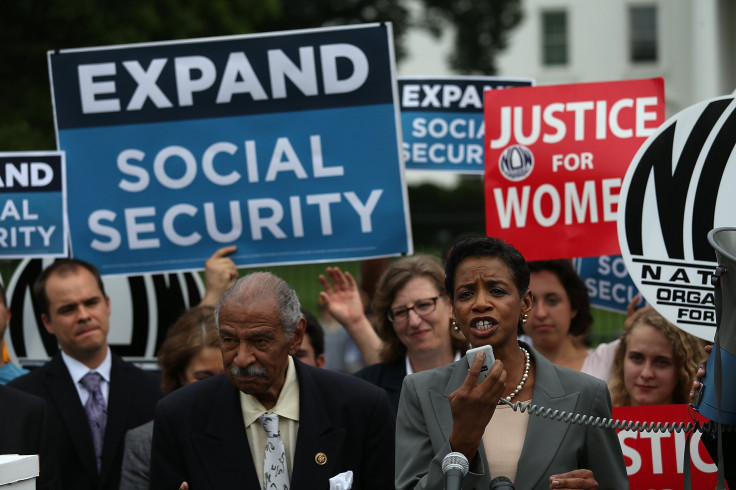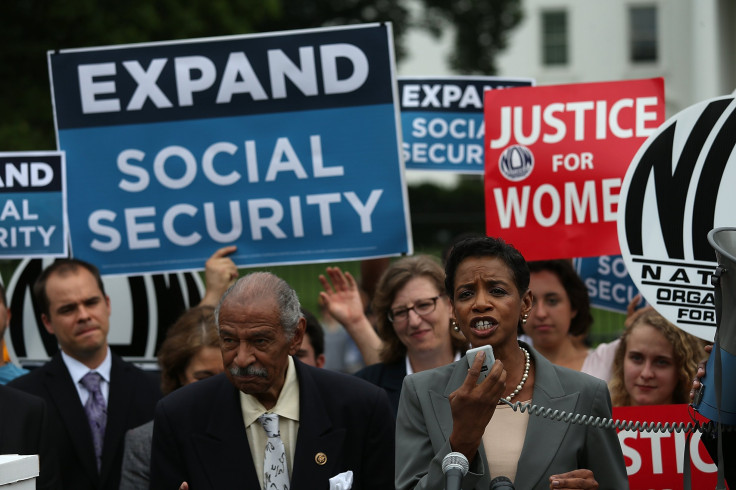Social Security's $34.2 Trillion Problem

For better or worse, Social Security is a vital program for our nation's seniors. According to an analysis from the Center on Budget and Policy Priorities, the mere fact that Social Security provides guaranteed monthly income to eligible retired workers ensures that more than 15 million of them remain above the federal poverty line. This results in a senior poverty rate of less than 9%. Comparatively, it would be an estimated 40.5% without Social Security.
This article originally appeared in the Motley Fool.
But as you're probably also well aware, the Social Security program is in trouble -- and it seemingly gets worse with each passing year.
Social Security Is 16 Years Away From Big Trouble
The release of the Social Security Board of Trustees' annual report last summer brought with it some terrifying forecasts. According to the half-dozen Trustees, Social Security is expected to begin paying out more in benefits than it's generating in revenue by 2022. That's only four years away. By 2034, after just 12 years of cash outflows, its roughly $3 trillion in asset reserves, which is primarily invested in special-issue bonds, is expected to be completely exhausted.
The depletion of these asset reserves is often a source of confusion among the public -- especially millennials. While it sounds scary, it doesn't mean Social Security is going bankrupt. I repeat, Social Security isn't going bankrupt. The program's 12.4% payroll tax on earned income between $0.01 and $128,400, as of 2018, ensures that it'll never go bankrupt, at least as long as people keep working and the payroll tax remains Social Security's primary source of funding.
What is an issue is the current payout schedule. If Social Security's asset reserves are exhausted by 2034, the Board of Trustees has projected the need for an across-the-board cut in benefits of up to 23%. That's scary considering that data from the Social Security Administration shows 62% of seniors are reliant on Social Security for at least half of their monthly income, and 34% lean on the program for essentially all of their income (90% to 100%).
This popularly referenced cut to benefits encompasses what would need to happen between 2017 and 2091 to "fix" Social Security. In other words, what measures need to be taken to ensure the solvency of the program through 2091.
Of course, cutting benefits isn't the only option over this 75-year period, known as the "long-term" estimate from the Board of Trustees. Raising revenue and eliminating the predicted $12.5 trillion cash shortfall between 2034 and 2091 would all but ensure that benefits won't need to be cut at all.
But, whether you realize it or not, things could be much, much worse than just a $12.5 trillion cash shortfall.
America's Most Important Social Program Is Facing A $34 Trillion Shortfall
Also included in the Board of Trustees' 261-page report is a relatively short section on its "infinite horizon projections." As the name implies, these are projections that encompass the very long-term -- i.e., beyond 75-year -- needs of Social Security. Per the report, Social Security is facing a $34.2 trillion cash shortfall for the infinite horizon.
Understandably, the further the Board of Trustees looks out into the distance, the less accurate or reliable the estimates become as the number of unforeseen variables increases. Nevertheless, a cash shortfall that's almost triple the size of the 75-year shortfall is yet another wake-up call to lawmakers in Washington that change is needed.
As is often the case, the longer lawmakers wait to address the shortfall, the more painful the solution becomes. Back in 1983, the Reagan administration's major overhaul of Social Security was undertaken with the program facing about a 1% actuarial deficit -- i.e., the amount payroll taxes would need to rise to eliminate the program's cash shortfall. As of 2017, the actuarial deficit for the 75-year period through 2091 stood at 2.83%, or almost three times as much as when Reagan was president. According to the infinite horizon projection, the actuarial deficit is a worrisome 4.2%.
Taking into account how consumers would alter their behavior as a result of payroll tax hikes, the Trustees have estimated the need for a 4.3% increase to the payroll tax ad infinitum if Social Security is to remain solvent "infinitely." This would mean an immediate increase in the payroll tax from 12.4% to 16.7% of earned income. Keep in mind that if you work for someone else, half of your payroll tax responsibility is covered by your employer, with the remainder on your shoulders. Thus, under such a scenario, you'd see an increase in payroll tax liability to 8.35% from 6.2%. The self-employed, however, would face the full 4.3% hike to 16.7%.
For the average American family bringing home about $50,000 in income a year, we'd be talking about roughly $1,000 to $2,000 a year extra being sent to Social Security beyond what's already being deducted.
Plenty Of Solutions, With No Consensus
Yet here's what's both interesting and disappointing: There are no shortage of Social Security "fixes." Democrats and Republicans, while sporting dozens of potential proposals, each have one core solution that resolves Social Security's long-term cash shortfall.
Democrats have proposed raising or eliminating the maximum taxable earnings cap, which is the $128,400 limit on which Social Security's 12.4% payroll tax is applicable. This cap allows high-income workers who earn more than $128,400 a year to escape Social Security's payroll tax. Raising or eliminating this cap would require the rich pay more into the program, providing much-needed revenue to completely offset Social Security's long-term cash shortfall.
On the other hand, Republicans would prefer gradually raising the full retirement age to between 68 and 70, up from its expected peak of 67 in 2022. Raising the full retirement age -- the age where the Social Security Administration deems a retired worker eligible to receive 100% of their benefit -- would help account for rising life expectancies and reduce long-term expenditures. This would be accomplished by coercing retired workers to wait longer to claim benefits or by requiring early claimants to accept a steeper reduction in their monthly payout.
Both of these solutions work, but they have absolutely no support from the opposing party. In order to fix Social Security's $34 trillion problem, a middle ground will, at some point, need to be reached. Until then, today's workers need to save, invest, and do whatever else they can to reduce their future reliance on Social Security.
The Motley Fool has a disclosure policy.





















